Micheliolide Inhibits Liver Cancer Cell Growth Via Inducing Apoptosis And Perturbing Actin Cytoskeleton
- PMID: 31754310
- PMCID: PMC6825479
- DOI: 10.2147/CMAR.S216870
Micheliolide Inhibits Liver Cancer Cell Growth Via Inducing Apoptosis And Perturbing Actin Cytoskeleton
Abstract
Purpose: Micheliolide (MCL) is an effector compound of the flower which has been traditionally used to treat inflammation and cancer patients in oriental medicine. MCL has killing effects on several cancer and immune cells by modulating apoptosis, cell cycle, and metabolism. However, the detail of the mechanisms of anti-cancer activity remains to be elucidated and the effect on liver cancer cells is unknown.
Methods: Cell proliferation was determined by CCK8 and clone formation assay. The xenograft liver cancer model formed by injecting Huh7 cells into NUDE mice was used to evaluate the effects of MCL on liver cancer cells in vivo. We evaluated the stemness of cells with spheroid formation assay and flow cytometry assay. The apoptosis was determined by Annexin V assay. F-actin staining and ROS were performed to detect the impairment of the F-actin cytoskeleton and mitochondria.
Results: Here, we first show that MCL inhibits liver cancer cells both in vivo and in vitro by triggering apoptosis which was reduced by anti-oxidant, but not cell-cycle arrest. In addition, MCL induces mitochondrial ROS and caspase-3 activation. Also, we found that the aggregation of mitochondria and the perturbation of F-actin fibers in the MCL-treated liver cancer cells coincidently occurred before the induction of apoptosis and mitochondrial ROS.
Conclusion: These results suggest that F-actin perturbation is involved in impaired mitochondria and apoptosis. Therefore, MCL can be a potent therapeutic reagent for liver cancer, primarily targeting the actin cytoskeleton.
Keywords: Micheliolide; ROS; actin cytoskeleton; apoptosis; liver cancer.
© 2019 Yu et al.
Conflict of interest statement
The authors report no conflicts of interest in this work.
Figures





Similar articles
-
Micheliolide inhibits gastric cancer growth in vitro and in vivo via blockade of the IL-6/STAT3 pathway.Pharmazie. 2019 Mar 1;74(3):175-178. doi: 10.1691/ph.2019.8816. Pharmazie. 2019. PMID: 30961685
-
Viscum articulatum Burm. f. aqueous extract exerts antiproliferative effect and induces cell cycle arrest and apoptosis in leukemia cells.J Ethnopharmacol. 2018 Jun 12;219:91-102. doi: 10.1016/j.jep.2018.03.005. Epub 2018 Mar 16. J Ethnopharmacol. 2018. PMID: 29555410
-
Sinoporphyrin sodium mediated photodynamic therapy inhibits the migration associated with collapse of F-actin filaments cytoskeleton in MDA-MB-231 cells.Photodiagnosis Photodyn Ther. 2016 Mar;13:58-65. doi: 10.1016/j.pdpdt.2015.12.008. Epub 2015 Dec 29. Photodiagnosis Photodyn Ther. 2016. PMID: 26742781
-
The novel indole compound SK228 induces apoptosis and FAK/Paxillin disruption in tumor cell lines and inhibits growth of tumor graft in the nude mouse.Int J Cancer. 2012 Aug 1;131(3):722-32. doi: 10.1002/ijc.26401. Epub 2011 Oct 20. Int J Cancer. 2012. PMID: 22015944
-
Cinobufagin Induces Apoptosis in Osteosarcoma Cells Via the Mitochondria-Mediated Apoptotic Pathway.Cell Physiol Biochem. 2018;46(3):1134-1147. doi: 10.1159/000488842. Epub 2018 Apr 13. Cell Physiol Biochem. 2018. PMID: 29669353
Cited by
-
Parthenolide and Its Soluble Analogues: Multitasking Compounds with Antitumor Properties.Biomedicines. 2022 Feb 21;10(2):514. doi: 10.3390/biomedicines10020514. Biomedicines. 2022. PMID: 35203723 Free PMC article. Review.
-
Sesquiterpene Lactones and Cancer: New Insight into Antitumor and Anti-inflammatory Effects of Parthenolide-Derived Dimethylaminomicheliolide and Micheliolide.Comput Math Methods Med. 2022 Jul 18;2022:3744837. doi: 10.1155/2022/3744837. eCollection 2022. Comput Math Methods Med. 2022. Retraction in: Comput Math Methods Med. 2023 Jul 12;2023:9856528. doi: 10.1155/2023/9856528. PMID: 35898475 Free PMC article. Retracted. Review.
-
Sestrin2: multifaceted functions, molecular basis, and its implications in liver diseases.Cell Death Dis. 2023 Feb 25;14(2):160. doi: 10.1038/s41419-023-05669-4. Cell Death Dis. 2023. PMID: 36841824 Free PMC article. Review.
-
Exploring natural products as apoptosis modulators in cancers: insights into natural product-based therapeutic strategies.Naunyn Schmiedebergs Arch Pharmacol. 2025 Jul;398(7):8189-8214. doi: 10.1007/s00210-025-03876-8. Epub 2025 Feb 27. Naunyn Schmiedebergs Arch Pharmacol. 2025. PMID: 40014131 Review.
-
Comprehensive Structure-Activity Profiling of Micheliolide and its Targeted Proteome in Leukemia Cells via Probe-Guided Late-Stage C-H Functionalization.ACS Cent Sci. 2021 May 26;7(5):841-857. doi: 10.1021/acscentsci.0c01624. Epub 2021 Apr 28. ACS Cent Sci. 2021. PMID: 34079900 Free PMC article.
References
LinkOut - more resources
Full Text Sources
Research Materials

